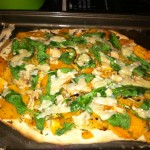The Protein Debate Part 2
Hello readers!
My last post focused on protein, specifically digestion and absorption of it and how to increase the bioavailability of nutrients in your food by eating more raw plant foods and with the help of digestive enzymes. This post is dedicated to the discussion of “clean” sources of protein.
Most fitness buffs would describe a perfectly balanced meal as a grilled boneless, skinless chicken breast, steamed broccoli, and brown rice. While you could certainly eat worse things, I would like to examine the notion that chicken breast is a “clean” protein. When I say “clean”, I mean void of added hormones, antibiotics, pesticides, and unhealthy feed. If you are buying your chicken (or other meat) at the grocery store or at a restaurant, likely it contains all or most of the above added ingredients. Same is true for beef, pork, dairy, eggs, and some fish. There are a variety of reasons why these additives are used, most of which include a higher yield and lower cost to the food growers, but all of them are extremely dangerous to us and detrimental to our overall health. Don’t take my word for it… look up antiobiotic overexposure and the potential dangers, and then consider that 80% of the antiobiotics used in this country are used in farm animals that we eat. The conditions these animals are raised in can be filthy, and the animals often end up very sick. They are fed a diet of feed that is unnatural to their bodies, so they are given additional medicine to keep them alive. I could go on about the horrors of factory farming, but I think you get the picture.
Our bodies are fantastic, incredibly precise machines that are constantly working to eliminate toxins that we are exposed to in the air we breathe, water we drink, and food we eat. But it is no wonder that in this age of food additives and artificial everything, our bodies can no longer keep up with the demand of detoxification. Getting back to protein… yes, we need protein/amino acids (as discussed in Part 1). But there are better ways to get protein without ingesting all of these unnecessary and harmful toxins. For example, plant based protein sources (all plants contain protein), and animals raised without the use of harmful hormones and antibiotics.
When choosing animal protein, look for the following:
- *Grass “Finished” (not just grass fed) Beef
- Hormone and Antibiotic Free
- Organic (indicates pesticide free)
- Omega-3, Vegetarian Fed Eggs
- Nitrate-Free Pork Products
- rBST-Free Dairy Products
- Wild Fish (check out the Monterey Bay Aquarium list of sustainable fish)
Some of my favorite plant proteins (remember, you must eat a variety of plants to obtain all of the essential amino acids):
- Quinoa (ancient Incan grain, nutty flavor, and contains ALL amino acids!)
- Beans, legumes
- Nuts and Seeds
- Green Leafy Vegetables (spinach, broccoli, etc.) – all contain protein!!
- Soybeans (also a comlete protein!)
In summary, for best absorption and quality of protein without unnecessary toxins, include many plant foods and only “clean” animal proteins. Your overall protein requirement will be less, and you will be consuming a higher content of micronutrients, which will make your body function optimally! The end result will be greater energy, sleep, skin, muscle tone, and overall well being.
Thanks for reading!




